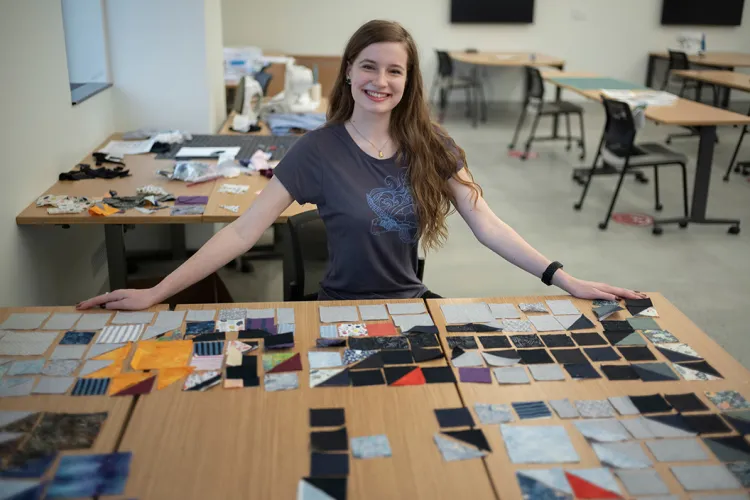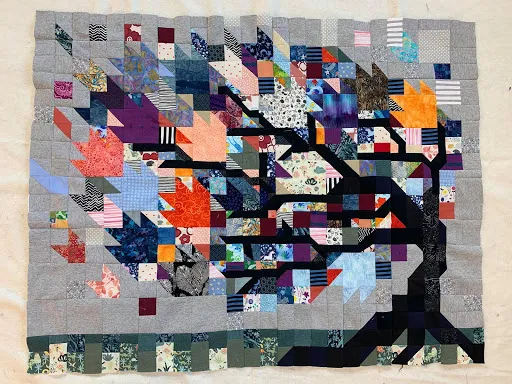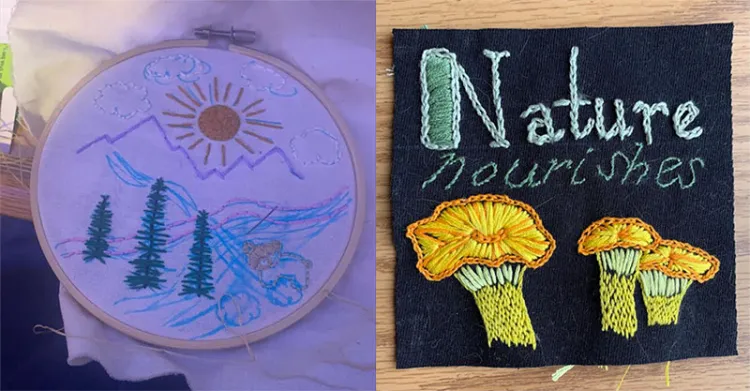Hannah Watkins ’21 Stitches Swarthmore Together with Community Quilt

Setting up base at a workspace in Singer Hall, Hannah Watkins ’21 has already logged over 100 hours on the project.
Hannah Watkins ’21 is working hard to stitch together aspects of the Swarthmore community — quite literally. Watkins, a biology major from Anchorage, Alaska, is making a community quilt, with the mission to create a tactile reminder of this unusual year.
“It felt like the whole experience of running into people day-to-day and the spontaneity of Swarthmore was gone,” says Watkins. “Everything we do we have to sign up for in advance or prearrange. I miss running into someone at Sci Center or Sharples, or having an impromptu sit-down with them.”
Professor of History Allison Dorsey’s class on quilting as a Black art form first introduced quilting to Watkins, who described the class as “transformative.” For Watkins, who was already crafting voraciously in quarantine, a community quilt seemed the natural solution to her feelings of isolation.
Watkins logged more than 100 hours to organize the project. First, she applied for and secured funding from the Office of Student Engagement (OSE) and the Center for Innovation and Leadership (CIL). With the help of Susan Eagar and Katherine Cerino Jones in Events Management, she obtained a workspace for this project in Singer Hall. After sending a mass email to all students, faculty, and staff members, Watkins received a score of T-shirts from many different community members, many of whom she had never met before. Lynn Grady and Mary Kassab of Dining Services donated an apron and Dining Services T-shirt; Jacob Clark ’21 donated a “Know Justice, Know Peace” shirt.
“I liked the community-based nature of the project,” says Clark, one of the quilt’s most dedicated participants.
Watkins used these cloth donations to piece together the main section of the quilt. The concept art is a striking play on the traditional “tree of life” quilt block. “This year,” she says, “we visualize our community as a tree in a terrible storm, struggling to remain rooted amid gale-force winds.”

Hannah Watkins ’21 used cloth donations from students, faculty, and staff members to piece together the main section of the quilt.
Watkins collaborated with the Sewing, Upcycling, Crafting and Knitting group on campus to send 20 free embroidery kits home to students so that they could make their own embroidery squares. These will form the quilt’s border. For Swatties like Clark, who took up embroidery over quarantine, this opportunity was ripe for the picking.
“I liked the fact that it was going to get me back into a craft I started a while ago,” says Clark, a Spanish major who grew up in rural Michigan. He embroidered an elaborate nature scene with trees, a mountain, a sun, and a river. “I chose the scene to represent my love of nature, especially now,” Clark says. “It brings me peace.”
Maria Aghazarian, a Swarthmore librarian who had never embroidered before, illustrated her square with golden chanterelle mushrooms and the words “Nature nourishes.” “The chanterelles are specific to last spring, when I started learning about all sorts of mushrooms, but specifically edible mushrooms,” Aghazarian says. In the summer, she and her friends had found several pounds of golden chanterelle mushrooms in full flush, which they cooked for dinner. “It was literally like ‘nature nourishing’ both mentally, emotionally, and physically,” she says. “It was really beautiful.”

Jacob Clark ’21 embroidered an elaborate nature scene with trees, a mountain, a sun, and a river (left), while librarian Maria Aghazarian illustrated her square with golden chanterelle mushrooms and the words “Nature nourishes.”
To complement the quilt, Watkins is creating a Google Doc summarizing the contributions to the quilt and collecting the impressions and testimonies of the Swarthmore community from this extraordinary year. The back of the quilt will also be covered with these written accounts of the past year from community members.
Watkins hopes the quilt will be finished by Commencement. What will she do with the quilt once it’s complete? “I’m really not sure,” she says. She’s considered leaving it at Swarthmore to be displayed for a few years, or submitting it to a COVID-19-related art exhibition. “One thing I do feel certain about it is I don’t want it to be put in a box and left in storage. I’d honestly rather it be used in picnics.”



